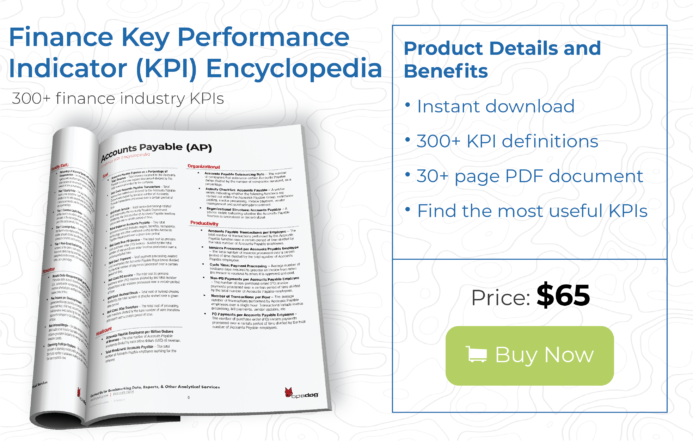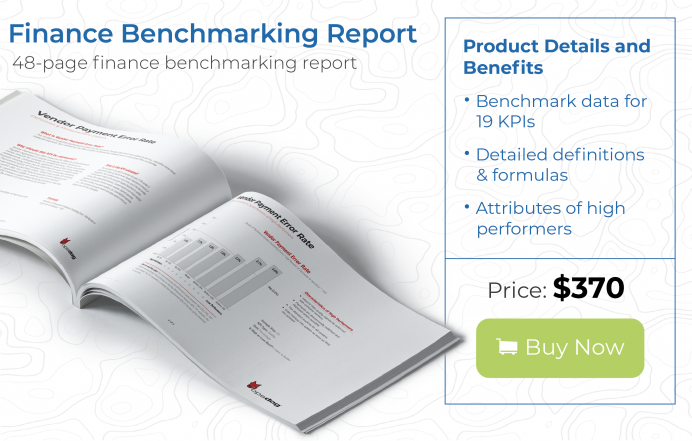Though the responsibilities of the Accounts Payable Department vary with the size of a company, in general, the Accounts Payable Department manages and pays the bills of a company. From processing incoming invoices, which could include paying the electricity bill to providing travel management and ensuring that all of the company’s suppliers are paid in full and on time, the Accounts Payable Department does it all. Paying vendors in this way may even lead to lenient credit terms on the part of vendors, thus saving the company money. So how can your company make sure your Accounts Payable Department is working at tip top shape? By measuring accounts payable performance metrics, of course!
Accounts payable metrics are defined as the quantitative values used to determine the effectiveness and efficiency with which specific goals and objectives are achieved within a company’s Accounts Payable Department. Accounts payable metrics should focus on both employee work quality, individual employee productivity, as well as the cost of keeping the Accounts Payable Department operational.
Without measuring accounts payable productivity and performance metrics, companies could open themselves up to financial and reputational liabilities. For instance, if a company consistently sends out late payments, or payments with too many errors, the company may lose lenient credit terms, which increases cost or reduces the available cash on hand.
Benefits of measuring and benchmarking Accounts Payable Metrics and KPIs in your company business intelligence efforts include:
- Increased accounts payable process transparency
- Reduced accounts payable cost by driving down duplicate work activities
- Measured department and employee performance toward attainable accounts payable goals
- Fostered problem-solving work atmosphere
- Increased accountability of accounts payable staff
Let’s take a look at a few important examples of accounts payable metrics.
Accounts Payable Performance Metrics # 1: Accounts Payable Transactions per Employee
The Accounts Payable Transactions per Employee accounts payable productivity metric is defined as the division between the total number of transactions performed by the Accounts Payable function over a certain period of time and the total number of Accounts Payable employees.
A low value for this accounts payable productivity metric can indicate various inefficiencies such as poor invoice quality, non-user friendly accounts payable software interfaces, a high volume of invoices requiring manual entry or overstaffing within the Accounts Payable Department. To increase this value, look to streamline the processes the Accounts Payable Department utilizes, and identify methods to reduce low quality invoices. This can include providing extra training for less productive employees, implementing automation software to perform invoice matching, etc.
Accounts Payable Performance Metrics # 2: Vendor Payment Processing Cycle Time
This accounts payable metric measures the number of business days required to process an invoice from a company supplier, or vendor. The day the invoice is received by the Accounts Payable Department is typically considered to be the first business day, while the day the invoice is approved and paid out to the supplier is typically considered to be the last day measured by this metric.
A low value for Vendor Payment Processing Cycle Time is the goal, as it both keeps the company’s relationship with vendors in good standing, and it improves overall employee productivity and work quality. To keep this value high, accounts payable managers should standardize the processes and formats for invoice submission, implement methods to reduce the number of paper invoice submissions and improve internal performance management practices. These steps reduce the potential for errors due to highly manual and unstandardized payment submission forms, and allows managers to efficiently monitor employee performance.
Accounts Payable Performance Metrics # 3: Percentage of Duplicate Invoice Payments
Let’s face it, duplicate work effort happens. People forget they’ve already finished a task, individual employees are not aware of what their coworkers are doing and so forth. Needless to say, things will be done more than once. You don’t want to pay for duplicate work effort and you definitely don’t want to double pay a vendor.
Begin tracking the Percentage of Duplicate Invoice Payments accounts payable metric to measure the division between the number of invoices that are paid more than once over a certain period of time and the number of invoices paid over the same period of time, taken as a percentage.
A low value for this account payable metric is the target so look to make the accounts payable payment process as transparent as possible. This can entail situating vendor information within a centralized online database where all accounts payable employees can view orders, invoices, payments, discounts and other relevant information. When coupled with standardized drop-down menus, this centralized database allows accounts payable employees to see which invoices have already been processed, and which ones still need to be completed. Keeping vendor information in a centralized location also reduces the overall time it takes to process payments as employees do not have to search multiple locations for the information they need which keeps vendor satisfaction high. Implementing KPI dashboards to track employee tasks can also be useful as it allows accounts payable managers to keep on top of each employee’s productivity levels to see which ones need further training in the accounts payable payment process, thereby further reducing instances of duplicate work.
Accounts Payable Performance Metrics # 4: Vendor Payment Error Rate
The Vendor Payment Error Rate accounts payable metric is defined as the division between the number of outgoing payments processed by the Accounts Payable Department that contained an error and the total number of transactions initiated over the same period of time, taken as a percentage. Errors can include wrong addresses, incorrect amounts of money paid, duplicate payments, etc.
Though everyone makes mistakes, a low value for this account payable performance metric should be pushed for as a high number of payment errors can open the company to financial and legal ramifications. For instance, excessive invoicing errors can lead to a loss of lenient credit terms and a high number of vendor disputes. A possible method to decrease this value is to push towards a standardized process for making payments and capturing and updating vendor information.
Accounts Payable Performance Metrics # 5: Accounts Payable Expense as a Percentage of Total Revenue
A bit different than the previous metrics, this accounts payable performance metric measures the division between the total expense incurred by the Accounts Payable function and the total revenue generated by the company over the same period of time, taken as a percentage.
The Accounts Payable Expense as a Percentage of Total Revenue accounts payable metric can be used to both measure just how much money is being used from the company’s total revenue to fund the Accounts Payable Department as well as the number of employees staffed within the Accounts Payable Department itself. While a generally low value should be desired, the exact amount is dependent on the needs of the company. Seek to improve departmental budget forecasting processes to determine the exact number of employees the Accounts Payable Department needs. Both overstaffing and understaffing can lead to productivity issues.
Accounts Payable Metrics Summary and Resources
An Accounts Payable Department that measures the right metrics will keep your company’s lights on and doors open. After all, if you don’t pay your bills, everything will get shut off. Implementing the right accounts payable metrics in your operation, whether using simple hand tabulated tracking, Excel sheets, or even advanced accounts payable business intelligence apps, will all reduce cost, increase your employee morale, and keep vendors happy.
Do you need help with accounts payable benchmarking or business intelligence implementation? Contact us to learn more about our Accounts Payable Benchmarking and BI services. We’ll quickly help you benchmark your business and provide you with presentation-ready deliverables at an affordable price.

